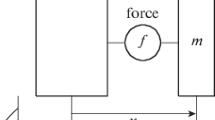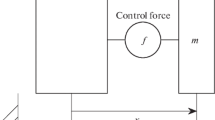Abstract
The present article deals with the problem on constructing a guaranteeing time of a given control beginning for a shock isolator protecting an object on a movable base from impacts acting on this base. The initial moment of control action can either be ahead (anticipation) or lag behind (delay) the moment of the disturbance beginning. It is assumed that the shock shape is unknown, but its duration is given and the acceleration of the base is described by an constant-sign function of time with a given integral. As a control force bounded in magnitude that acts between the base and an object to be protected, we set the constant control of a given duration that has been previosly obtained for an instantaneous shock (impact) for a problem without anticipation. The performance index to be minimized is the maximum displacement of the object relative to the base. Based on the value of the performance index, a comparison of the proposed optimization at the moment of the control beginning with other control methods, in particular, with the optimal solution with a single switching is performed.
Similar content being viewed by others
REFERENCES
V. V. Guretskii, “On one optimal control problem,” Izv. Akad. Nauk SSSR, Mekh., No. 1, 159–162 (1965).
V. V. Guretskii, “On the problem of minimizing the maximum displacement,” Tr. Leningr. Politekh. Inst., Mekh. Protsessy Upr. 307, 11–21 (1969).
E. Sevin and W. Pilkey, Optimum Shock and Vibration Isolation (Shock and Vibration Information Analysis Center, Washington DC, 1971).
M. Z. Kolovskii, Automatic Control of Vibration Protection Systems (Nauka, Moscow, 1976) [in Russian].
N. N. Bolotnik, Optimization of Amortization Systems (Nauka, Moscow, 1983) [in Russian].
D. V. Balandin, N. N. Bolotnik, and W. D. Pilkey, Optimal Protection from Impact, Shock, and Vibration (Gordon and Breach Science, Amsterdam, 2001).
W. D. Pilkey, D. V. Balandin, N. N. Bolotnik, et al., Injury Biomechanics and Control: Optimal Protection from Impact (Wiley, Hoboken, NJ, 2010).
N. N. Bolotnik and V. A. Korneev, “Limiting performance analysis of shock isolation forttransient external disturbances,” Nelineinaya Din. 11 (1), 147–168 (2015).
N. N. Bolotnik and V. A. Korneev, “Shock isolation with anticipating control for external disturbances of various shapes,” J. Comput. Syst. Sci. Int. 57 (3), 390–406 (2018).
N. N. Bolotnik and V. A. Korneev, “Guaranteeing anticipating control in shock isolation problem,” Dokl. Phys. 63, 326–330 (2018).
V. A. Korneev, “Protection of an object on a movable base using anticipating control under the worst disturbances,” J. Comput. Syst. Sci. Int.58, 86–94 (2019).
Funding
This study was accomplished within the state project АААА-А20-120011690138-6 .
Author information
Authors and Affiliations
Corresponding author
Additional information
Translated by A.A. Borimova
About this article
Cite this article
Korneev, V.A. Use of Constant Anticipating and Delayed Control in Shock Isolation Problem Applied to an Object on a Movable Base. Mech. Solids 55, 277–287 (2020). https://doi.org/10.3103/S0025654420020120
Received:
Revised:
Accepted:
Published:
Issue Date:
DOI: https://doi.org/10.3103/S0025654420020120




